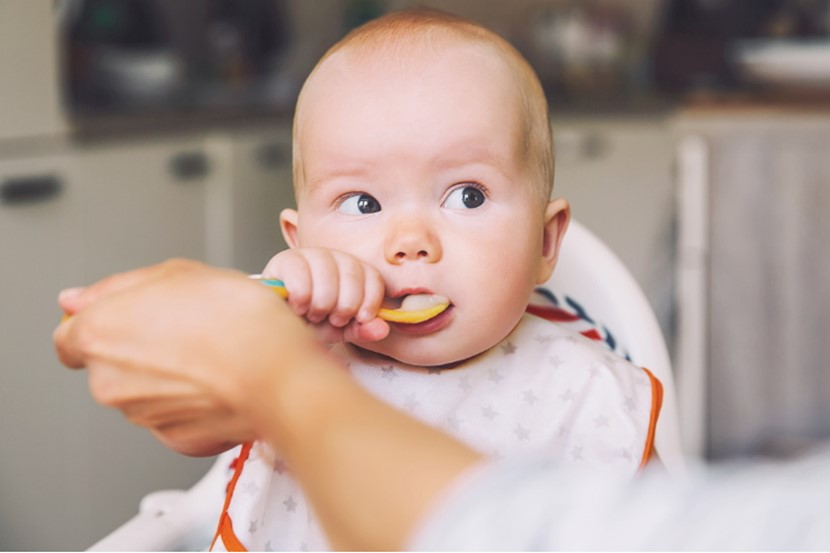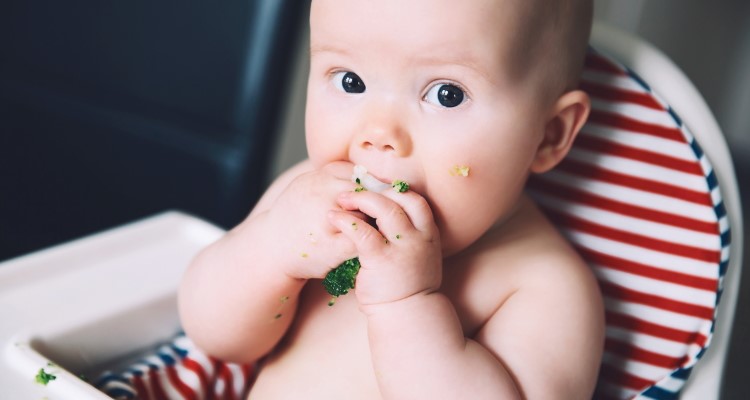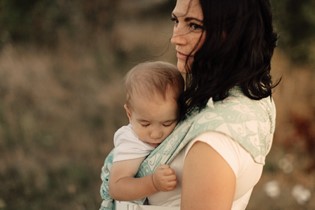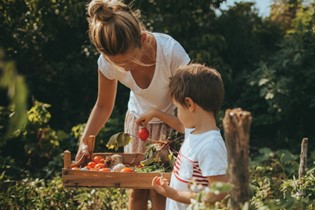The easy guide to starting baby on solids

Introducing your child to solid food can seem a daunting task, but it’s actually quite intuitive, reassures dietitian Jennifer Douglas. Here she breaks down the process by age and stage.
Feeding your baby and toddler is an experience that many parents love, but it does come with challenges! The process of starting your baby on solids is an exciting time. Here’s a simple guide to feeding your child in their first two years.
0-6 MONTHS
Your baby’s main food is breastmilk. Breastfeeding can be challenging at the start – if you’re having difficulties, do seek help from a lactation consultant. If you can’t breastfeed, you can use donor milk or formula. Bone broth given to babies in bottles is not safe and can give them very high doses of vitamin A, or lead to malnutrition. There’s no need for you to avoid eating particular foods while breastfeeding unless your baby reacts to something, in which case you should discuss this with your doctor or a registered dietitian.
FROM 6 MONTHS
When your baby is ready (from around six months old, but not before four months old), they can start on solids. Your baby is ready when they can hold their head up with less help, when they are making chewing movements with their mouth, when they’re bringing objects to their mouth and are showing interest in food. There are two common approaches to starting solids.
SPOON-FEEDING
The most common way of feeding your baby is with a spoon. Start with runny puréed foods and progress to thicker more mashed purée, and then, by 12 months of age, to foods the family is eating. When you start feeding purée it is best to use foods without additional salt or sugar. Making your own baby food really is worth the effort because you can control what goes into it. At the beginning, Baby will eat only a small amount of food so your focus at this stage is simply to give your baby the experience of eating in a relaxed and positive feeding environment.

|
GOOD FOODS TO START YOUR BABY ON: ✔ Puréed beef, lamb, chicken, cooked egg and lentils mixed with breastmilk or formula. ✔ Iron-fortified rice or baby cereals mixed with breastmilk or formula. Add fruit or vegetables if your baby is prone to constipation. ✔ Puréed vegetables, such as pumpkin, kumara, peas, carrot, parsnip, broccoli and avocado. ✔ Puréed fruit, such as stewed apple, pear and peach. |
BABY-LED WEANING
The Ministry of Health does not currently recommend baby-led weaning due to the risk of choking and potential growth and iron concerns. However, there are safe ways to do it. Babies shouldn’t start baby-led weaning until they’re at least six months old as they’re not developmentally ready before then. To avoid choking, it’s important that your baby feeds themselves and that you are not putting food into their mouth. Finger foods should be the length and width of their whole hand, and food should be soft enough that when you test the food your tongue can squash the food to the roof of your mouth.

|
GOOD BABY-LET WEANING FOODS TO START YOUR BABY ON: ✔ Beef or lamb strips cooked medium rare. ✔ Iron-fortified baby cereal mixed with breastmilk and spread on vegetables, or used to as a dip for vegetables or soft fruit. ✔ Steamed or roasted vegetables, eg pumpkin, kumara, carrot, and broccoli, all in baby-hand-sized pieces. ✔ Soft fruits in palm-sized portions, eg banana, soft pear and soft stone fruits. ✔ White or wheatmeal toast fingers with avocado, hummus, smooth peanut butter, or puréed meat on top. |
WHAT BABY-LED WEANING MEALS MAY LOOK LIKE:
Start with just one meal a day offered at a time when you and your baby are happy and relaxed. Breastfeed your baby before offering solids. You can move to more meals and snacks over the day when your baby is ready. Remember to embrace the mess that comes with starting solids, as touching and exploring the food is equally important as eating it.
Iron-rich foods are important first foods for your baby. By six months of age your baby has used most of the iron stores that they received in pregnancy. Iron-rich foods should be offered daily – these are puréed meat, fish, chicken, lentils, cooked egg and iron-fortified baby cereals.
In the first 12 months of life, expose your child to a wide variety of foods, with a focus on family foods. Most babies are willing to try new foods, so exposure to as many different tastes and textures is important before more selective eating starts when they’re older. It’s important to offer the more bitter vegetables, such as broccoli, cauliflower and spinach, regularly but don’t mix them with fruit or sweet vegetables all the time. You can also purée like-coloured vegetables together to expose your baby to different coloured foods, such as pumpkin and carrot, or peas and broccoli. Most babies love eating food with added spices and herbs (but no salt) in their meals, so don’t be afraid of flavour. You’ll find that putting in the ground work at this age means your baby will be more likely to overcome their normal ‘fussy’ stage more quickly as a toddler.
6-12 MONTHS
Milk is still an important part of your baby’s diet at this early stage, and should continue as the main source of energy. You can offer water in a sippy cup at mealtimes from six months, but milk will continue to be their main drink. Over the six- to 12-month period you should be offering your baby foods the family is eating, and work towards making the texture of the purée more challenging. Move from smooth purées to more lumpy, soft foods, and then to whole foods. By the time your baby is around 12 months old they should be eating foods which are of a similar texture to those the rest of the family is regularly eating. You can change from giving your baby breastmilk before their food at around the eight- to nine-month mark.
INTRODUCING ALLERGEN FOODS
As you introduce solids it’s important that all allergen foods are introduced from six months of age and before 12 months. Foods to introduce from six months are smooth peanut butter, cooked egg, wheat (cereal or bread), cow’s milk in the form of cheese and yoghurt, fish, seafood and soy (usually contained in bread as soy flour). Even babies who are at risk of allergy, eg they have a parent or sibling with an allergy, should have allergens introduced in the first year of life. If you’re concerned, discuss with your GP or a registered dietitian.
There are important roles that you and your child have in feeding and it’s important to remember these at mealtimes to ensure there’s no extra pressure on your baby to eat.
|
YOUR ROLE AS A PARENT/CARER: ✔ To decide what food your child will be offered. ✔ To decide where your child will eat, eg at the table, highchair. ✔ To decide when your child will eat, eg lunch, afternoon tea.
YOUR CHILD'S ROLE IN FEEDING: ✔ To decide whether they are going to eat the food or not. ✔ To decide how much food they’re going to eat, eg half a teaspoon or a whole bowl full. |
12-24 MONTHS
Breastfeeding can continue until your child is two years of age, and even beyond if that suits. If your baby is formula-fed, cow’s milk can become their main drink from 12 months. There’s no need to change to toddler milk if your child is eating a variety of family foods. Toddlers should have around 300-400ml of milk over the day and not more than 500ml, as the focus is now on food for nutrition rather than milk. Water should be offered regularly over the day.
By now, meals and snacks should be at set times over the day. Offering protein foods, such as cheese, yoghurt, meat, fish, egg and nut butters at most meals can help improve satiety and prevent constant requests for snacks. Having breaks in-between meals helps develop hunger and your child’s interest in trying new foods at mealtimes.
|
GOOD SNACK FOODS FOR YOUR ACTIVE TODDLER MIGHT BE: ✔ Yoghurt and fruit ✔ Cheese and crackers ✔ Peanut butter on toast ✔ Vegetable sticks with hummus |
You should continue to limit salt in your toddler’s diet and avoid high-salt foods such as chips and processed savoury snacks. Foods with naturally occurring sugar, such as fruit and milk products, does not need to be avoided, but drinks and foods with additional sugars, such as baking, should be occasional only.
At this stage it’s normal for your child to go from accepting all foods and eating large volumes to not wanting to eat as much and becoming more selective in what they eat. It’s important not to pressure your child to finish their meal or ‘have one more bite’. Continue to offer relaxed family meals – this might involve giving yourself some time out to calm down if your child is being challenging. If they refuse the food, don’t offer alternatives, just accept that they don’t like the food today and will have another chance to eat at the next meal. If you’re worried that the range of food your child accepts has become too limited, consult your GP or a registered dietitian.
When kids are offered a wide variety of mostly unprocessed food in a fun, relaxed family eating environment, they’ll thrive, grow and learn to love healthy food for the rest of their lives.

THE INTUITIVE BABY
Your baby is an intuitive eater who knows exactly how much they need to eat and drink to grow perfectly. Babies know whether they want to eat a food or just explore it by picking it up and looking at it. They also know whether they want to be fed in a baby-led way or be spoon-fed, and they’ll communicate this to you by being keen to feed themselves or by showing that they need help. It’s very likely that over the day your baby will like a combination of finger foods to feed themself and some puréed meals that you feed them. It’s important to listen to your baby’s feeding cues and let them guide you on how they want to be fed, whether they want to eat, and how much.
Jennifer Douglas is a registered dietitian specialising in children’s nutrition. She has over 14 years’ experience working with families to improve their health with good food. Jennifer also holds intuitive baby feeding and family nutrition seminars around Otago and Southland. Visit her website at jumpstartnutrition.co.nz.

AS FEATURED IN ISSUE 48 OF OHbaby! MAGAZINE. CHECK OUT OTHER ARTICLES IN THIS ISSUE BELOW

















